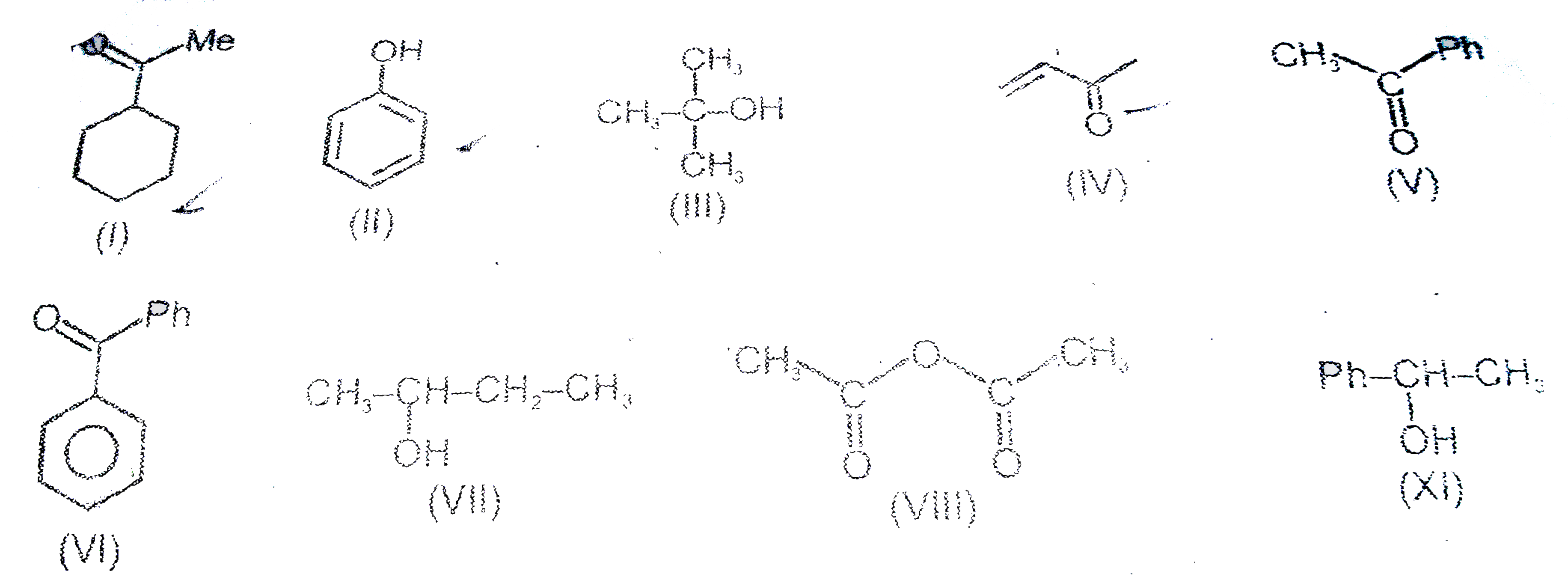Lucas reagent is
anhydrous and conc. HCl
anhydrous and conc. HCl
anhydrous and conc. HCl
anhydrous and conc. HCl
The correct Answer is:B
Step-by-Step Solution:
1. Understanding the Question:
The question asks about Lucas reagent, which is used in organic chemistry to classify alcohols.
2. Identifying the Components of Lucas Reagent:
Lucas reagent is a combination of anhydrous zinc chloride (ZnCl2) and concentrated hydrochloric acid (HCl).
3. Analyzing the Options:
The options provided are:
- Anhydrous calcium chloride and concentrated HCl
- Anhydrous zinc chloride and concentrated HCl
- Anhydrous aluminum chloride and concentrated HCl
- Anhydrous palladium chloride and concentrated HCl
4. Selecting the Correct Option:
Among the options, the second one, "anhydrous zinc chloride and concentrated HCl," matches the definition of Lucas reagent.
5. Understanding the Function of Lucas Reagent:
Lucas reagent is used to classify alcohols based on their reactivity. It works through a substitution reaction where the hydroxyl group (OH) of an alcohol is replaced by a chloride ion (Cl-) from zinc chloride.
6. Conclusion:
The correct answer to the question is that Lucas reagent is "anhydrous zinc chloride and concentrated HCl."
Final Answer:
Lucas reagent is anhydrous zinc chloride (ZnCl2) and concentrated hydrochloric acid (HCl).
---
The question asks about Lucas reagent, which is used in organic chemistry to classify alcohols.
Lucas reagent is a combination of anhydrous zinc chloride (ZnCl2) and concentrated hydrochloric acid (HCl).
The options provided are:
- Anhydrous calcium chloride and concentrated HCl
- Anhydrous zinc chloride and concentrated HCl
- Anhydrous aluminum chloride and concentrated HCl
- Anhydrous palladium chloride and concentrated HCl
Among the options, the second one, "anhydrous zinc chloride and concentrated HCl," matches the definition of Lucas reagent.
Lucas reagent is used to classify alcohols based on their reactivity. It works through a substitution reaction where the hydroxyl group (OH) of an alcohol is replaced by a chloride ion (Cl-) from zinc chloride.
The correct answer to the question is that Lucas reagent is "anhydrous zinc chloride and concentrated HCl."
Lucas reagent is anhydrous zinc chloride (ZnCl2) and concentrated hydrochloric acid (HCl).
Topper's Solved these Questions
- STRUCTURAL IDENTIFICATION & PRACTICAL ORGANIC CHEMISTRYBOOK - RESONANCE ENGLISHCHAPTER - STRUCTURAL IDENTIFICATION & PRACTICAL ORGANIC CHEMISTRYEXERCISE - Jee main
6 Videos
- STRUCTURAL IDENTIFICATION & PRACTICAL ORGANIC CHEMISTRYBOOK - RESONANCE ENGLISHCHAPTER - STRUCTURAL IDENTIFICATION & PRACTICAL ORGANIC CHEMISTRYEXERCISE - APSP
30 Videos
- STRUCTURAL IDENTIFICATION & PRACTICAL ORGANIC CHEMISTRYBOOK - RESONANCE ENGLISHCHAPTER - STRUCTURAL IDENTIFICATION & PRACTICAL ORGANIC CHEMISTRYEXERCISE - Exercise-3
3 Videos
- SOLID STATEBOOK - RESONANCE ENGLISHCHAPTER - SOLID STATEEXERCISE - Part- IV
21 Videos
- THERMODYNAMIC & THERMOCHEMISTRYBOOK - RESONANCE ENGLISHCHAPTER - THERMODYNAMIC & THERMOCHEMISTRYEXERCISE - INORGANIC CHEMISTRY(P-Block Elements)
26 Videos
Similar Questions
A compound [A] has the formula C4H8O2. When reacted with a Grignard reagent, CH3MgBr, it takes up two molecules of it and upon acidification gives an alcohol [B]. The alcohol on reacting with Lucas reagent gives white coludiness on standing for sometime. When the alochol is oxidised, a compound [C] is produced with a pleasant smell. It neither reacts with Tollen's reagent, nor with Fehling's reagent.
The compound [A] is
View SolutionA compound [A] has the formula C4H8O2. When reacted with a Grignard reagent, CH3MgBr, it takes up two molecules of it and upon acidification gives an alcohol [B]. The alcohol on reacting with Lucas reagent gives white coludiness on standing for sometime. When the alochol is oxidised, a compound [C] is produced with a pleasant smell. It neither reacts with Tollen's reagent, nor with Fehling's reagent.
The compound [A] is
View Solution
Knowledge Check
An organic compound (A)C8H10O was subjected to a series of test in laboratory.
It was found that this compound :
(i) Rotates the plane polarized light.
(ii) Evolves H2 gas with Na.
(iii) Reaches with I2 and NaOH to produce yellow ppt.
(iv) Does not react with Br2/CCl4
(v) Reacts with hot KMnO4 to form (B)C7H6O2, which can also be synthesized by benzene and carbonyl chloride followed by hydrolysis.
(vi) Loses optical acitvity as a result of reduction with Red P+Hi to form C.
(vii) Reacts with Lucas reagent in about 5 minutes.
Find out structure of compound A:A B
B C
C D
D
A compound [A] has the formula C4H8O2. When reacted with a Grignard reagent, CH3MgBr, it takes up two molecules of it and upon acidification gives an alcohol [B]. The alcohol on reacting with Lucas reagent gives white coludiness on standing for sometime. When the alochol is oxidised, a compound [C] is produced with a pleasant smell. It neither reacts with Tollen's reagent, nor with Fehling's reagent.
The alcohol [B] is
View SolutionPredict in which of the following cases, the reaction with Lucas reagent will be immediate, slow or will not take place at all room temperature ?

View Solution
X gives white turbidity with Lucas reagent instantly. X and Y both turn blue litmus solution red. Y can be:
View SolutionArrange the following in order of increasing reactivity to wards Luca's reagent: (i) Butan-1-o! (ii) Butan-2-ol (iii) 2-Methylpropan-2-ol
View SolutionX' is a smallest optically active alkanol. On dehydration it can form Y number of alkenes (including stereoisomers). On reaction with Lucas reagent it forms Z number of alkyl halides (including stereoisomers). Report your answer as ZY.
View SolutionObserve the following compounds

Number of coumpound which can gives positive Haloform test =(x)
Number of compound which can gives positive Lucas reagent test =(y)
Report your answer (x+y)
View SolutionA compound 'D' (C8H16O) has following observation
(a) It reacts with Lucas reagent with in 5min.
(b) On heating in presence of acid given a compound X, which can decolorize KMnO4 as well as Br2/Cl4.
(c ) compound Xozonolysis−−−−−→YI2/NaOH−−−−−→2 moles of iodoform + sodium salt of dibasic acid Sodalime−−−−→n− butane
Then D, X, Y are
View Solution
